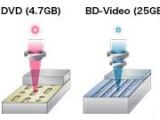Panasonic has developed a 4-layer, 100GB Blu-ray disc that it claims will last for 100 years by using a tellurium suboxide palladium-doped phase-change recording film, called Te-O-Pd. The film has a high transmittance and crystallization rate which allows them to layer it on without losing data quality. Each of the four layers on the disc has a 25GB storage capacity totaling up to 100GB and is capable of a 2x writing speed. Te-O-Pd is inorganic and not-very-soluble, so when the discs finally do get tossed in a century or so, they won't toxify the Earth too much, according to ArsTechnica.
The 100-discs are not yet in production and are aimed at the long-term storage market. CDs, which were originally touted as being able to last ages, turned out to have relatively short lifespans. Instead of decades upon decades of data storage, CDs ended up lasting for as little as 5-10 years because, as it turns out, people's burning, handling, and storage of the discs varied wildly. Outside of the perfect lab environment, which only tests the effects of humidity and temperature on discs over time, Panasonic's so-called "100-year durability" discs may in fact not last quite so long.
Even if they do last that long, the same source wonders if anyone who burns important data to one of these will have Blu-ray drives available to read them 100 years from now.
The Blu-ray Disc is an optical disc with the same dimensions as the DVD disc: 12 cm in diameter and 1.2 mm in thickness. By using a combination of the 405-nm-wavelength blue-violet laser, which is a shorter wavelength than the red laser used by DVD, and a high-density objective lens with a numerical aperture of 0.85, BD uses a laser beam spot that is only about 1/5 the size used by DVD. Thanks to these technologies, a single-layer BD-Video disc can store five times more data than a DVD disc.

 14 DAY TRIAL //
14 DAY TRIAL // 
